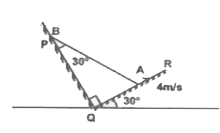In the above question, the velocity of end O when end A hits the gournd is
zero
along the horizontal
along the vertical
at some inclination of the ground (≠90∘)

Instantaneous axis of rotation will pass through O.
∴v0=0
Topper's Solved these Questions
- BOOK - DC PANDEYCHAPTER - ROTATIONAL MECHANICSEXERCISE - Level 21videos
ROTATIONAL MECHANICS
- BOOK - DC PANDEYCHAPTER - ROTATIONAL MECHANICSEXERCISE - Level 2 Subjective36videos
ROTATIONAL MECHANICS
- BOOK - DC PANDEYCHAPTER - ROTATIONAL MECHANICSEXERCISE - Level 2 Single Correct26videos
ROTATIONAL MECHANICS
- BOOK - DC PANDEYCHAPTER - ROTATIONEXERCISE - (C) Chapter Exercises39videos
ROTATION
- BOOK - DC PANDEYCHAPTER - ROTATIONAL MOTIONEXERCISE - Integer Type Questions17videos
ROTATIONAL MOTION
Similar Questions
In the above question, if at the end of 4 sec, the string be cut, the position of each particle in next 2 seconds will respectively be -
View SolutionA thin rod of length L and mass M is held vertically with one end on the floor and is allowed to fall. Find the velocity of the other end when it hits the floor, assuming that the end on the floor does not slip?
View Solution
Knowledge Check
- Question 1 - Select One
In the above question, the velocity of end A at the instant it hits the ground is
A√3glB√12glC√6glDnone of these - Question 2 - Select One
In the above question, the angular velocity will:
AincreaseBdecreaseCnot changeDnothing can be said - Question 3 - Select One
In the above quation, velocity with which the sone hits the ground is
A39.2m/sB19.6m/sCzeroD78.4m/s
In the above question, the position of point D from end A of the rod at which there is equal strain on both the wires is
View SolutionA rod of length l whose lower end is fixed on a horizontal plane, starts toppling from the vertical position. The velocity of the upper end when it hits the ground is.
View SolutionA rod of length L whose lower end is fixed along the horizontal plane starts to topple from the vertical position. The velocity of the upper end of the rod when it hits the ground is
View SolutionA rod of length L is sliding on a frictionless surface as shown in the figure. Velocity of end A is 4m/s along the wall. Find the velocity of end B, when end B makes 30∘ with wall PQ.
 View Solution
View SolutionIn the above experiment, the value of end correction is
View Solution

